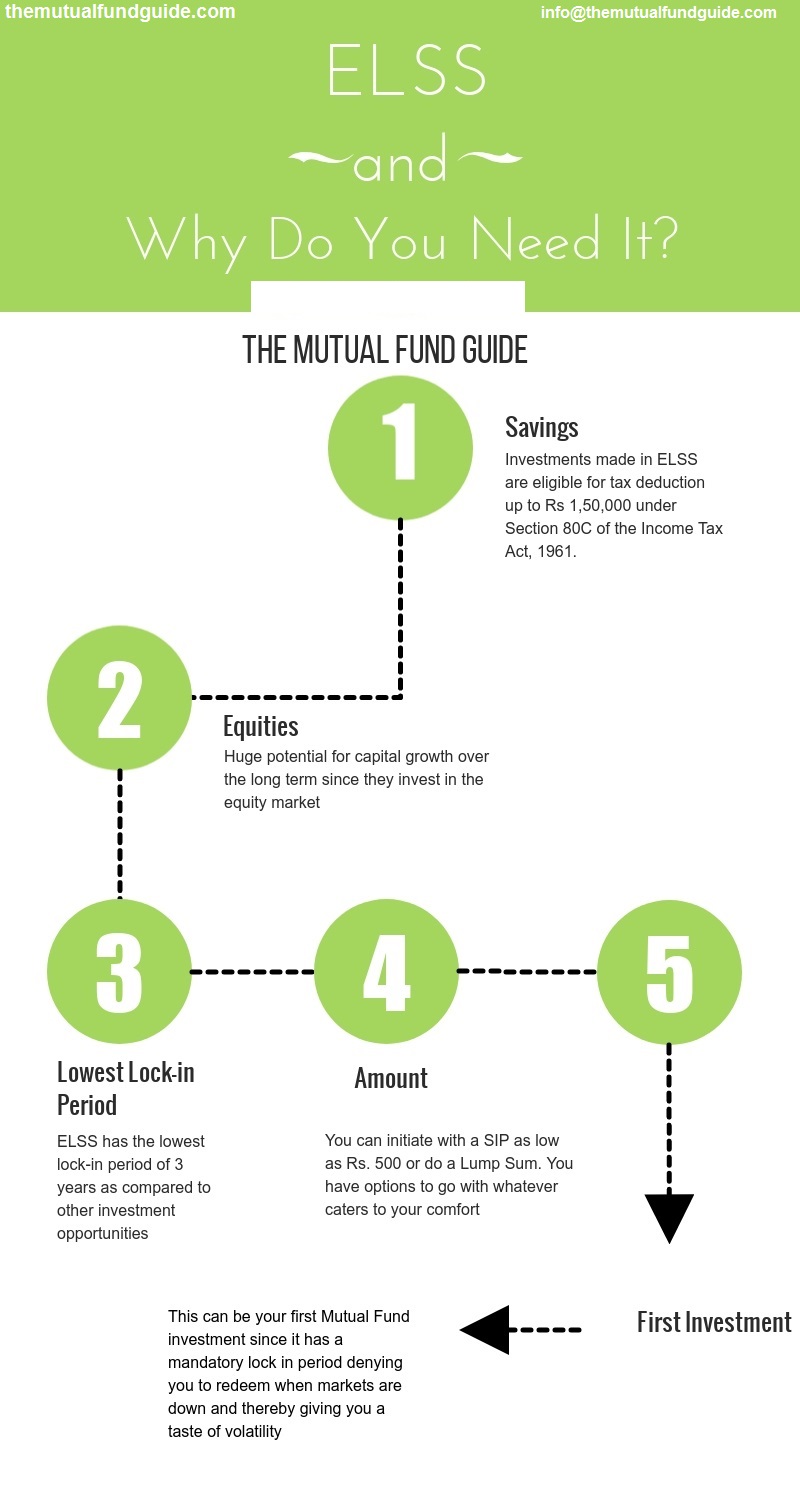Equity Linked Savings Scheme, better known as ELSS Funds or Tax Saving Mutual Funds allow an individual or HUF to invest in a diversified equity mutual fund to claim a deduction up to Rs. 1.5 Lakhs under Section 80C of the Income Tax Act 1961.
What
are tax saving mutual funds?
Elss means tax saving mutual funds that allow tax deductions
under 80c of the Income tax act.
Tax saving mutual funds have a short lock in period of 3
years as opposed to other tax saving instruments with lock in period ranging
from 5 to 7 to 10 years.
Elss mutual funds is your best option since it provides both
tax saving as well as capital appreciation.
To get the true benefits of elss funds, they should be first
looked at as an investment and a tax-saving option later.
Additional reading: Click Here to read our complete review of Axis Long Term Equity Fund
How
does tax saver mutual fund work?
A tax saving mutual fund is similar to a flexi cap mutual
fund in the sense that it does not have any restrictions with regards to caps.
It is free to invest wherever it wishes to as long as 80% of
the portfolio is invested in equities at all times.
It comes with a lock in period of 3 years, for sip each
instalment would need to complete 3 years before you can withdraw it.
Since it comes with a lock in period of 3 years, fund
managers have a sense of stability in terms of AUM which provides them with
more room to take concentrated bets.
Every tax fund is managed differently from the other since
there are no set rules as such.
Therefore, relying merely on past returns can be very
harmful for your portfolio, instead a better understanding of the philosophy of
the fund and your needs is what is required.
Is
ELSS taxable after 3 years?
Elss funds are taxed like any other equity mutual fund.
No tax is imposed for profits under Rs 1 lakh.
For profits exceeding Rs 1 lakh, 10% Long Term Capital Gains
tax (LTCG) is imposed.
Short Term Capital Gains tax (STCG) cannot be imposed on tax
saving mutual funds since they have a lock in period of 3 years so by default,
they stay invested for more than a year.
Can I
withdraw tax saver mutual fund?
You can withdraw your elss funds only after they have
completed 3 years.
For SIP investments in tax saving funds, each sip instalment
is considered as a fresh purchase and therefore each SIP instalment would need
to complete 3 years.
No partial redemptions or transfers are allowed before the
completion of 3 years.
Additional reading: Click Here to read our complete review of Reliance Tax Saver Fund
Is
ELSS good for long term investment?
Even though elss funds come with a 3 year lock in period it
is better to invest in them with a longer time horizon, say 7 years or more.
This is because most elss funds work more or less like a
flexi cap mutual fund.
Therefore your tax saving funds would not be restricted by
caps and would be invested across the market.
They serve dual purpose of investments as well as tax
savings.
Therefore, while you are saving taxes, you could also use
the taxes saved for a long term goal.
Benefits
of ELSS Funds
Tax
saving
The first and most obvious benefit is that it helps you in
reducing your taxable income significantly.
You can invest up to Rs 1,50,000 in elss funds to save
yourself from paying taxes to that amount.
Even though tax saving is the most obvious benefit, tax
saving mutual funds should be planned as much as the rest of your portfolio.
Lowest lock in period
Elss funds have the lowest lock in period among all the tax
saving instruments
|
Instrument |
Lock in period |
|
Elss funds |
3 years |
|
Public
Provident Fund |
15 years |
|
National
Savings Certificate |
6 years |
|
Bank Fixed
Deposits |
5 years |
Highest Returns
Elss funds have the potential to generate the highest returns
from all the tax saving instruments.
This is because elss funds by rule need to invest mostly in
equity.
Therefore, tax saving funds also have the most potential to
generate inflation beating returns.
Tax saving mutual funds have the most potential to transform
your money into wealth.
Elss
funds and other tax saving instruments
Elss is not the only tax saving instrument but it is the
most rewarding of the lot.
Elss
and National Pension Scheme (NPS)
NPS is more for your long term and retirement goals whereas
elss funds can be used for medium term to long term goals.
Medium term goals here mean from 5 to 7 years and beyond.
Elss funds can be redeemed anytime after 3 years whereas NPS
can be redeemed only once you retire.
Elss funds allow for tax deductions up to Rs 1,50,000
whereas NPS allows for up to Rs 2,00,000.
Elss and Tax Saving Fixed
Deposit
Tax saving fixed deposit has a 5 year lock in period whereas
elss funds have a lock in period of 3 years.
Historically speaking, elss funds on an average have
generated better returns than tax saving fixed deposit.
Interest income from tax saving fixed deposit, irrespective
of the amount is added to taxable income whereas for elss funds only profits
above Rs 1,00,000 are taxed at 10%.
Elss and ULIP’s
Ulip’s are a mix of insurance policy along with exposure to
either debt or equity.
It provides the best of neither though.
Ulip’s have high costs and low transparency as compared to
elss funds.
Ulip’s have a lock in period of 5 years whereas elss funds
have of 3 years.
Returns from ulip’s are tax free while profits over Rs
1,00,000 in elss funds are taxed at 10%.
For portfolio enquiries, email us with your doubts at info@themutualfundguide.com













